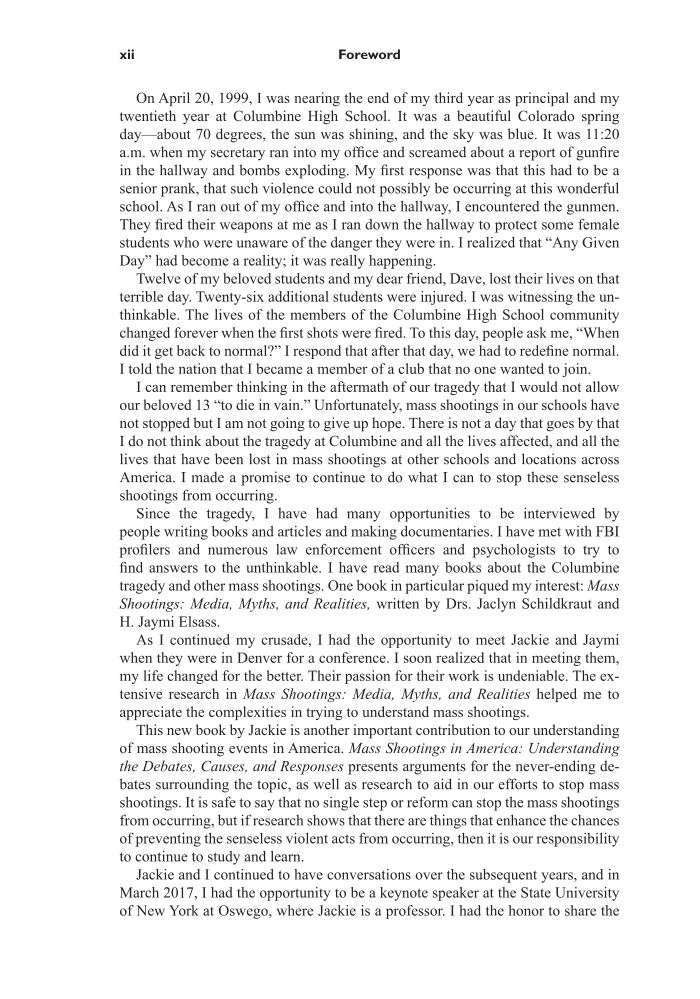xii Foreword On April 20, 1999, I was nearing the end of my third year as principal and my twentieth year at Columbine High School. It was a beautiful Colorado spring day—about 70 degrees, the sun was shining, and the sky was blue. It was 11:20 a.m. when my secretary ran into my office and screamed about a report of gunfire in the hallway and bombs exploding. My first response was that this had to be a senior prank, that such violence could not possibly be occurring at this wonderful school. As I ran out of my office and into the hallway, I encountered the gunmen. They fired their weapons at me as I ran down the hallway to protect some female students who were unaware of the danger they were in. I realized that “Any Given Day” had become a reality it was really happening. Twelve of my beloved students and my dear friend, Dave, lost their lives on that terrible day. Twenty-six additional students were injured. I was witnessing the un- thinkable. The lives of the members of the Columbine High School community changed forever when the first shots were fired. To this day, people ask me, “When did it get back to normal?” I respond that after that day, we had to redefine normal. I told the nation that I became a member of a club that no one wanted to join. I can remember thinking in the aftermath of our tragedy that I would not allow our beloved 13 “to die in vain.” Unfortunately, mass shootings in our schools have not stopped but I am not going to give up hope. There is not a day that goes by that I do not think about the tragedy at Columbine and all the lives affected, and all the lives that have been lost in mass shootings at other schools and locations across America. I made a promise to continue to do what I can to stop these senseless shootings from occurring. Since the tragedy, I have had many opportunities to be interviewed by people writing books and articles and making documentaries. I have met with FBI profilers and numerous law enforcement officers and psychologists to try to find answers to the unthinkable. I have read many books about the Columbine tragedy and other mass shootings. One book in particular piqued my interest: Mass Shootings: Media, Myths, and Realities, written by Drs. Jaclyn Schildkraut and H. Jaymi Elsass. As I continued my crusade, I had the opportunity to meet Jackie and Jaymi when they were in Denver for a conference. I soon realized that in meeting them, my life changed for the better. Their passion for their work is undeniable. The ex- tensive research in Mass Shootings: Media, Myths, and Realities helped me to appreciate the complexities in trying to understand mass shootings. This new book by Jackie is another important contribution to our understanding of mass shooting events in America. Mass Shootings in America: Understanding the Debates, Causes, and Responses presents arguments for the never-ending de- bates surrounding the topic, as well as research to aid in our efforts to stop mass shootings. It is safe to say that no single step or reform can stop the mass shootings from occurring, but if research shows that there are things that enhance the chances of preventing the senseless violent acts from occurring, then it is our responsibility to continue to study and learn. Jackie and I continued to have conversations over the subsequent years, and in March 2017, I had the opportunity to be a keynote speaker at the State University of New York at Oswego, where Jackie is a professor. I had the honor to share the
Document Details My Account Print multiple pages
Print
You have printed 0 times in the last 24 hours.
Your print count will reset on at .
You may print 0 more time(s) before then.
You may print a maximum of 0 pages at a time.















































































































































































































































































































































































